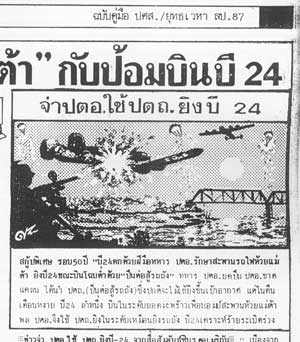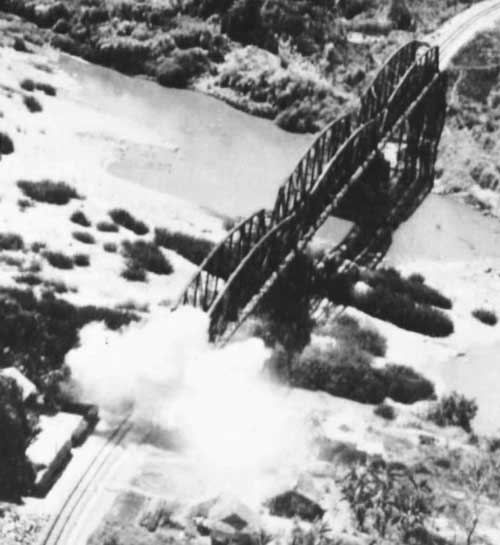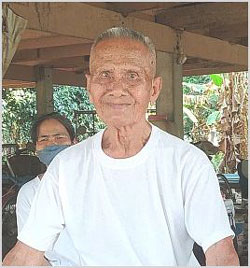
World War 2 Veteran Feuay Dtang-rid of the Royal Thai Army Engineering Reserve Battalion 4
While tracking two B-24 crash sites around Uttaradit in 2022 1, we had met a 104-year-old resident who couldn’t verify first-hand a crash site near his house simply because he had been far away at the time in the Royal Thai Army (RTA), maintaining what sounded like the Mae Sai – Kengtung Road. At this later date, we thought we would be missing an important opportunity if we did not revisit the old man to discuss his experiences during WW2, for he would have been on the northern road that the Imperial Japanese Army (IJA) used in its attempted invasion of India.
In addition, it is possible that he is the last surviving veteran of the RTA from WW2.
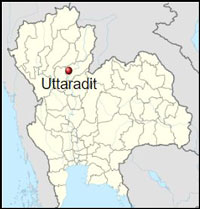 On the first of April, 2023, we revisited Feuay Dtang-rid at his house in Uttaradit for an entertaining two hours: He met us with a spritely gait and entered into a long, lucid discussion; 2
On the first of April, 2023, we revisited Feuay Dtang-rid at his house in Uttaradit for an entertaining two hours: He met us with a spritely gait and entered into a long, lucid discussion; 2
his entire demeanor belied his age. Born in Uttaradit 3 in 1918, he grew up working on his family’s tobacco farm. In late 1938, at age 21, per Thai tradition, he was ordained as a monk. He chose a five-year period, to end in 1943; during those five years, major changes occurred affecting his immediate future and that of Thailand: 4
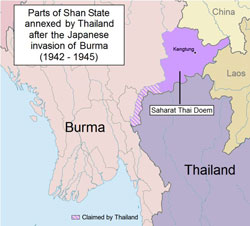 On 08 December 1941, the IJA entered Thailand by land from Cambodia and by sea. After some initial resistance by the RTA and the Royal Thai Air Force (RTAF), and subsequent dispute within the Thai Parliament, the Thai government leader, Field Marshall Phibun, signed a “Pact of Alliance” with Japan on 21 December 1941. A secret portion emphasized Thailand’s immediate assistance to Japan’s war effort, [particularly allowing access to Burma] in exchange for Japan’s assurance that it would return to Thailand its “lost territories” in Shan State, [as shown in purple on the map as Saharat Thai Doem 5 ] which included Kengtung State and parts of Mongpan State. 6
On 08 December 1941, the IJA entered Thailand by land from Cambodia and by sea. After some initial resistance by the RTA and the Royal Thai Air Force (RTAF), and subsequent dispute within the Thai Parliament, the Thai government leader, Field Marshall Phibun, signed a “Pact of Alliance” with Japan on 21 December 1941. A secret portion emphasized Thailand’s immediate assistance to Japan’s war effort, [particularly allowing access to Burma] in exchange for Japan’s assurance that it would return to Thailand its “lost territories” in Shan State, [as shown in purple on the map as Saharat Thai Doem 5 ] which included Kengtung State and parts of Mongpan State. 6
IJA units, having seized Rangoon in early March 1942, moved north to Taunggyi in May 1942, then turned east towards Kengtung, to take it on 28 May 1942. The RTA’s Phayap Army forces coming from the south joined the IJA there, with the IJA allowing the Phayap Army to occupy all of Kengtung State and part of Mongpan State. The Thai flag was raised there on 05 June 1942. 7
In January 1943 the RTA moved eastward from Kengtung forcing remaining Chinese troops back into Yunnan. Young described the terrain as “a rugged, mountainous area. Their few roads were little more than dirt tracks, limiting the mobility of an advancing army.” [This appraisal was offered by Edward Young in explaining the importance of RTAF support of ground forces advancing into the Eastern Shan States.] 8
 With this in mind, Phibun ordered the construction / improvement of 524 km of roads in the newly acquired territory to be completed in five months, ie, by the end of May 1943. 9
With this in mind, Phibun ordered the construction / improvement of 524 km of roads in the newly acquired territory to be completed in five months, ie, by the end of May 1943. 9
With that, in February 1943, the RTA established a Transportation Building Brigade with staff including personnel from the Civil Service Corps and the Department of Roads, plus three army engineering battalions, all under the command of an army colonel. 10 More details about the roads and schedule are described in the Appendix below.
With China’s VI Army forced back into Yunnan, combined with there never having been war declared between Thailand and China, in late February 1943, Chiang Kai-shek issued a conciliatory statement which effectively ended hostilities. 11
In August 1943, per an agreement signed with Japan in December 1941, Thailand annexed the land it had occupied in 1942 and it became an administrative division of Thailand called Saharat Thai Doem (‘Unified Former Thai Territories’) 12
At the end of 1943, 13 road construction / improvement work in Thailand’s annexed Saharat Thai Doem was apparently still very much in progress, a year after Phibun’s orders had been issued, and six months after his targeted completion date — for the schedule for the work scope had been grossly unrealistic. As a consequence, the army, needing more workers for the roads projects, put out a call through local puyaibans (village headmen) for volunteers to join the RTA and go north into the Saharat to construct / improve roads. The only requirement for volunteers was to be under the age of 50; married status was irrelevant. There were so many volunteers that they were chosen by drawing straws.
Feuay volunteered, won the draw, and joined the RTA to be assigned to Engineering Reserve Battalion 4. He was one of 80 troops, divided into four groups of twenty; while all were Thai, he recalls having difficulty in understanding the accent of those from the south. They all were trucked north from Uttaradit to standby in Lampang for four days, then on to Mae Sai and Kengtung on what he saw as well-maintained roads; after a wait of another four days in Kengtung, they were driven north on a narrow road to Nampong (น้ำปอง) on the Nampong River. The battalion’s workscope was not the Mae Sai-Kengtung Road as we had thought; but was what he described as a road running east or northeasterly out of Kengtung towards Sibsongbanna (Xishuangbanna) in Yunnan, China.
 At the Nampong River, one or more of the twenty-man groups built a bridge about 100 meters in length to span the river, using raw, unfinished teakwood; it might have been similar to the one shown here, 14 composed of simple four-meter spans. It was built during the dry winter season, so the river level would have been at low water. The remaining groups worked back towards Kengtung, widening the road to eight meters; ie, two lanes, with a dirt surface. All four groups then continued on past the bridge, working in groups of twenty, spaced out along the way, improving / widening a simple path through forest, intending to go through Bpa-faeg (ป่าแฝก) and Numdam (น้ำดำ) to the Chinese border at Sibsongbanna. Presumably the route approximated what would eventually become today’s Mong Lang Road ending at Mongla on the Nanlan River (a tributary to the Lancang, in turn a tributary to the Mekong). At this point, the Nanlan River forms the Burma-China border with Sibsongbanna in Yunnan on the far shore.
At the Nampong River, one or more of the twenty-man groups built a bridge about 100 meters in length to span the river, using raw, unfinished teakwood; it might have been similar to the one shown here, 14 composed of simple four-meter spans. It was built during the dry winter season, so the river level would have been at low water. The remaining groups worked back towards Kengtung, widening the road to eight meters; ie, two lanes, with a dirt surface. All four groups then continued on past the bridge, working in groups of twenty, spaced out along the way, improving / widening a simple path through forest, intending to go through Bpa-faeg (ป่าแฝก) and Numdam (น้ำดำ) to the Chinese border at Sibsongbanna. Presumably the route approximated what would eventually become today’s Mong Lang Road ending at Mongla on the Nanlan River (a tributary to the Lancang, in turn a tributary to the Mekong). At this point, the Nanlan River forms the Burma-China border with Sibsongbanna in Yunnan on the far shore.
Work turned out to be a seven day a week affair, each day ending about 4pm. Supervision was provided by someone with experienced in roadwork — which none in the work groups had. The supervisor was the only one armed; and he used the weapon only once, trying to kill an inquisitive tiger; wild animals in general avoided the group because there were so many of them and they were quite noisy. No bandits were seen — again the size of the group plus an assumption that, being army, they were well armed, probably detered them.
 The road was new — constructed, not improved, following simple paths close to the river, sticking to the river plain, avoiding traversing heights. Equipment was primarily manual; eg, “Thai hoes”, as shown in this photo. 15 There was one machine roller; Feuay didn’t recall how it was powered. There were other vehicles used for occasional connecting with Kengtung, for he recalls having to put chains on tires to get through the mud during the rainy season. The crews cut down the trees they encountered, which were up to 40 cm in diameter. It was not clear how they dealt with the resulting stumps. The road surface was simply rolled (compressed) dirt. Feuay doesn’t recall building any other bridges, so presumably lesser waterways were forded.
The road was new — constructed, not improved, following simple paths close to the river, sticking to the river plain, avoiding traversing heights. Equipment was primarily manual; eg, “Thai hoes”, as shown in this photo. 15 There was one machine roller; Feuay didn’t recall how it was powered. There were other vehicles used for occasional connecting with Kengtung, for he recalls having to put chains on tires to get through the mud during the rainy season. The crews cut down the trees they encountered, which were up to 40 cm in diameter. It was not clear how they dealt with the resulting stumps. The road surface was simply rolled (compressed) dirt. Feuay doesn’t recall building any other bridges, so presumably lesser waterways were forded.
Cooks procured food stuff locally — the single gun in the unit was not used for hunting; fuel for cooking and warmth in cold weather came from the scrap wood generated by their clearing efforts. The army provided clothing, as well as shelter described as individual “pup” tents, along with mosquito netting. While Feuay claimed the winter cold was tolerable — there was no snow —the army did supply blankets. Work would stop when it rained. Medical support was limited: quinine was available to treat malaria, but two workers in their group of 20 died of the disease in hospital in Kengtung; Feuay knew of deaths from malaria in the other groups. He was friendly with the supervisor and would accompany him when visiting the hospital in Kengtung where serious illnesses were treated. In the 20 months that they worked on the project, there was no mail, no communication with their families in Thailand. They were paid in Thai coin, four baht a month. That was considered adequate since the army supplied food, clothing, shelter.
They encountered no Japanese, Chinese, or Westerners during their time in Kengtung State; local Burmese seemed happy having the Thai military around since they were spending money. The workers saw no airstrips or aircraft. They encountered no hostilities. There was some sort of warning system set up for air attacks, for which the solution was to hide in streambeds; Allied records list twelve attacks on Kengtung during the period January 1944 to January 1945, after which no more were recorded (see Appendix). But Feuay recalled no air attacks or even alerts at his project.
They were unable to complete the road by Aug 1945, when the war ended, primarily because they were clearing woodland by hand — slow, hard work. Feuay was unable to put a name on the location where they stopped; but said it wasn’t as far as Bpa-faeg. At war’s end, his unit was apparently abandoned by the army and troops had to walk from where work had stopped to Kengtung and then on to Mong Hpayak. From there the army trucked the group back to Lampang where they were again abandoned. There, they went to the railyard at night and hid in railway freight cars (box cars) for the trip south. Wisarut Bholsithi noted that some other Thai troops returning from the north were not so lucky and had to walk the whole way back home. They typically followed the railway tracks south from Lampang because the railway offered the most direct route. During their march south, they would be passed by passenger trains carrying Japanese POWs to camps around Bangkok. Which is to say, the Thai government treated Japanese POWs better than its own soldiers after the war ended. 16
Comment:
The details provided by Feuay are roughly in general agreement with those provided in the RTA History, except that the locations he mentioned don’t appear on any map to which I have access. The language spoken in that part of Burma would have been readily understandable by Thais in the army, so there shouldn’t have been any misunderstanding as to location names. However, those location names might have changed over 80 years. And the local versions of names of features that he was familiar with might not be the same as those that appear on official maps. And, unfortunately, we currently have no access to Burma to query local people about place names.
APPENDICES
Saga of the RTA Engineering Battalions in the North 17
While beset by the arrival of an unusually wet rainy season in May 1942, the Thai army formally occupied Kengtung that June; however, the continual bad weather made quagmires of existing roadways and quickly halted the Thai effort to drive out Chinese troops east of Kengtung. With the road unpassable to motor transport, the army had to resort to elephants, horses, donkeys, mules to supply troops in the field; particularly critical was the delivery of quinine to treat malaria; the air force was enlisted to assist. In any case, Thai troops were not able to continue their offensive against the Chinese until early January 1943 and that was hindered by shortages which had become acute. The road conditions no doubt contributed to Phibun’s decision in January to order an urgent and massive roads project in Saharat Thai Doem.
From the time of Phibun’s 1943 orders to build / improve roads associated with Saharat Thai Doem, the sole purpose of the three army engineering battalions, numbered 1, 3, and 4, transferred from the Phayap Army was roadwork. The battalions formed a minor part of a 15,000 man Transportation Building Brigade largely composed of civilians.
The troops were provided hand tools, ie, shovels, hoes, picks, buckets, axes, knives, saws — which Feuay alluded to. And were nominally provided with power-saving machinery for excavation, cutting, filling, leveling, compacting soil, and for cutting trees and for breaking up rock: but in the case of Feuay’s unit, there was only a roller. Malaria and venereal disease were rife and medical services were limited by a severe shortage of medicine. Reasons for the army’s lack of support included:
- Supply by ship was severely curtailed by Allied attack or
threaten of attack. - Thailand’s allies were themselves overextended and
couldn’t provide support to Thailand. - What supplies were available were often controlled by
blackmarketeers who had no pride in country. The RTA
History remarked that this was Thailand’s first experience
with “war millionaires”.
Because Saharat Thai Doem was nearly 900 km north of Bangkok, military forces there became a “forgotten army”, and creative thinking had to cope with material and equipment shortages, eg:
- Rattan and bamboo were fashioned into rope for
structural connections. - Large logs were used as rollers to compact road surfaces.
- Fire were built to fracture boulders.
- Local beasts of burden replaced trucks destroyed by
bombing. - Local fabrics were purchased, then dyed, and sewn
into uniforms. - Blankets were fashioned into vests for warmth in winter.
- Doctors and medics looked to traditional medicines to
treat maladies.
This had been the environment in which Feuay and his 79 companions worked for more than a year and a half; and those who had arrived there earlier worked up to almost two and a half years. For Feuay, with his naturally optimistic countenance — and memories no doubt softened by the passage of almost 80 years, it had been a good time.
Maps of Saharat Thai Doem
Finding no map that showed Phibun’s planned roads, I tried to to get a feel for the locations that Feuay named in our interview by constructing my own map.
I started with Wikimedia’s map of the annexed area as a guide, supplemented by its text description of the border. 18
The easterly perimeter was defined by the border with China. The westerly was defined by the Salween River. The small northern and southern perimeters were not clearly defined. For the north, I followed an unnamed tributary flowing west to the Salween; for the south, I found no particular feature for guidance and arbitrarily used a prominent ridgeline that seemed to generally fit Wikimedia’s presentation. In the Wikimedia map, at the southern boundary, the area “claimed by Thailand” was given to the new State of Burma which was fostered by the Japanese: this was a compromise resulting from Japan having given a portion of British Burma, ie, parts of the Shan States, to Thailand.
A map in the RTA History showing tactical positions around Kengtung on 7-15 December 1943 also located names of significant towns in and around Saharat Thai Doem: 19
In the map legend, the only symbol relevant here is ![]() , which denotes national boundaries. Google Earth and Maps were not of much help in this regard since borders in that area don’t seem to have been drawn on them. Microsoft Bing Maps were used instead as guidance for adding borders.
, which denotes national boundaries. Google Earth and Maps were not of much help in this regard since borders in that area don’t seem to have been drawn on them. Microsoft Bing Maps were used instead as guidance for adding borders.
Using both Google and Microsoft Bing Maps, I then traced Phibun’s roads project largely by following present-day roads between the origins and destinations listed in the RTA History (see tables below), with the assumption that they were merely improvements of the WW2 roads project. In many cases, intermediate points on the lists do not show on the reference maps, and a lesser number were not found on any available maps. This then was the approximate scope of the work to implement Phibun’s January 1943 order to construct roads in Saharat Thai Doem: 20
Tables of Roads Project 21
Those locations not found on any available map are marked with an asterisk in the tables below. Some modern day “English equivalent” names diverge from simple transliteration, but are believed to be currently correct. Note that minor differences in spelling of place names may inadvertently appear on the map and in the list below. First priority roads are numbered, 1 through 5, and marked in red or dark red on the map; while second priority roads are designated A through E and marked in yellow.
First priority routes
Project Road 1: Mae Sai to Mongyang (271 km) 22
| RTA Name | English equivalent | Coordinates |
| แม่สาย | Mae Sai (Thailand) | N20°26.600 E99°52.870 |
| เมืองเลน | Mong Lin | N20°41.800 E100°06.400 |
| เมืองพยาค | Mong Hpayak | N19°55.400 E99°13.200 |
| บ้านปางช้อ | Ban Parng Law | N21°10.700 E99°41.500 |
| เมืองเชียงตุง | Kengtung | N21°17.700 E99°37.170 |
| บ้านกาดเต่า | Ban Kad Tao* | |
| บ้านหนองกัง | Ban Nong Kang* | |
| ท่าเปิน | Ta-pom | N21°33.600 E99°31.750? |
| เมืองหาง | Mong Ang* | |
| เมืองคัก (ชาก) | Mong Khat | N21°45.000 E99°27.800 |
| เมืองยาง | Mongyang | N21°50.700 E99°41.200 |
Project Road 2: Ban Nong Kang to Mong Chiang-lau (68 km)
| RTA name | English equivalent | Coordinates |
| บ้านหนองกัง | Ban Nong Kang* | |
| บ้านก่ำ | Ban Gum* | |
| ปางยาว | Bangyao* | |
| ปางฮัก | Banghag* | |
| ท่าตาปิง | Tar-ping | N21°30.050 E99°45.500 |
| เมืองมะ | Mongma | N21°36.760 E99°54.400 |
| เมืองลา | Mongla | N21°40.200 E100°01.000 |
| เชียงล้อ | Mong Chiang-lau | |
Project Road 3: Kengtung to Bang Mao (40 km) 25
| RTA name | English equivalent | Coordinates |
| เมืองเชียงตุง | Kengtung | N21°17.700 E99°37.170 |
| ดอยเหมย | Doi Mei (Loi Mwe?) | N21°10.300 E99°45.000 |
| ปางเม่า | Pang Mao 26 | N21°07.000 E99°48.000 |
Project Road 4: Mong Hpayak to Ban Hsopham (121 km) 27
| RTA name | English equivalent | Coordinates |
| เมืองพยาค | Mong Hpayak | N20°52.600 E99°56.000 |
| บ้าน น้ำนาง | Ban Nam Nang* | |
| บ้านวังฟ้า | Ban Wungfa* | |
| เมืองฮาน | Mong Han* | |
| บ้รนน้ำปุง | Ban Nam-pung* | |
| เมืองยอง | Mongyawng | N21°10.800 E100°21.400 |
| บ้านตั๊บ | Ban Tub* | |
| บ้านหัวขัว | Ban Hua-Khua* | |
| เมืองยู้ | Mongyu | N21°20.000 E100°33.500 |
| เมืองหลวยถึง | Mong Luai Thung* | |
| บ้านบกสบน้ำ | Ban Hsopham | N21°28.150 E100°44.000 |
Project Road 5: Mongyu to Mongwa (24 km)
| เมืองยู้ 28 | Mongyu | N21°20.000 E100°33.500 |
| หัวยตอง | Huai Tawng* | |
| เชียงของ 29 | Chiang Khong* | |
| เมืองวะ | Mongwa (Wan Ha) | N21°24.300 E100°24.000 30 |
The RTA History noted that priorities were established for completing these roads, with an overall deadline of May 1943, just five months after the order was given — which was wholly unrealistic. Further, five additional projects in Saharat Thai Doem were listed, should the army have completed the list above with time and resources left. Four of the five were apparently to connect to towns in the cardinal directions on the perimeter of Saharat Thai Doem, listed here clockwise from North, with the fifth totally internal to the territory:
Second priority routes (colored yellow on the map): 31
| Mangyang 32 to present-day Mangxin Port (Yunnan) |
||
| East | Bok Hsopnam to Mong Long (Yunnan) |
D |
| South | Kengtung to Fang (Thailand) | B |
| West | Kengung to Takaw (Burma) | A |
| (internal) | Mongwak to Mongwa (Saharat) | E |
And yet more scope, this inside Thailand proper, was added as future projects (but not mapped here since the scope is not in Saharat): 33
- Chiang Rai Province to Mong Fang
- Lampang to Chiang Mai
- Uttaradit Province to Si Satchanalai & Sawankhalok Districts in Sukhothai Province
- Phayao District, Chiang Rai Province, to Phrae Province
Unfortunately, the conclusion to my efforts above is that I still have no firm idea where Feuay and Engineering Reserve Battalion 4 might have worked.
Allied attacks on the Kengtung area 34
- WEDNESDAY, 26 JANUARY 1944
CBI – THEATER OF OPERATIONS – CHINA (14AF): In China, 18 P-40’s from Kunming bomb and strafe the airfield and barracks at Kengtung. - TUESDAY, 22 FEBRUARY 1944
CBI – THEATER OF OPERATIONS – CHINA (14AF): P-40s on armed reconnaissance strafe the airfield at Kengtung, China and nearby truck convoy. - THURSDAY, 2 MARCH 1944
CBI – THEATER OF OPERATIONS – CHINA (14AF): . . . 2 P-40s bomb and strafe the airfield and barracks at Kengtung. - MONDAY, 24 APRIL 1944
CBI – THEATER OF OPERATIONS – CHINA (14AF): . . . P-40s on a diversionary strike strafe numerous targets of opportunity at Kengtung, Burma. - THURSDAY, 7 DECEMBER 1944
CBI – THEATER OF OPERATIONS – CHINA (14AF): . . . 65 P-51s, P-40s, and P-38s on armed reconnaissance over wide areas of China attack storage areas, troops, bridges, railroad targets, and gun positions around Paoching, Anking, Hengyang, Tuhshan, Nan Tan, Kengtung . . . . - MONDAY, 11 DECEMBER 1944
CBI – THEATER OF OPERATIONS – CHINA (14AF): . . . 16 fighter-bombers attack Tien Ho Airfield at Canton and the Kengtung barracks in China. - WEDNESDAY, 27 DECEMBER 1944
CBI – THEATER OF OPERATIONS – CHINA (14AF): In China, 6 B-25s bomb the area W of Kengtung. . . . - SATURDAY, 30 DECEMBER 1944
CBI – THEATER OF OPERATIONS – CHINA (14AF): 4 B-24s damage a bridge W of Kengtung, China . . . . - WEDNESDAY, 26 JANUARY 1944
CBI – THEATER OF OPERATIONS – CHINA (14AF): In China, 18 P-40’s from Kunming bomb and strafe the airfield and barracks at Kengtung. - FRIDAY, 5 JANUARY 1945 35
CBI – THEATER OF OPERATIONS – CHINA (14AF): 4 B-25s pound 13 storage buildings at Kengtung, China. . . . 30 P-40s and P-38s attack various targets of opportunity, Sinsiang, and Kengtung, China . . . . - SATURDAY, 13 JANUARY 1945
CBI – THEATER OF OPERATIONS – CHINA (14AF): 6 B-25s blast 6 storage buildings at Kengtung, China. - SUNDAY, 14 JANUARY 1945
CBI – THEATER OF OPERATIONS – CHINA (14AF): . . . 7 B-25s hit targets at and W of Kengtung . . . .
Afterwords
A 1948 guidebook to Burma Roads: 36 gives compliments to Thai efforts on two roads in the now former Saharat Thai Doem:
First, describing the road from Mae Sai to Kengtung:
Kengtung to the Siamese Border (104½ miles)
. . . The road which is motorable throughout the year was metalled and gravelled, mostly by the efforts of the Siamese during their occupation of Kengtung between 1942 and 1945. . . . 37
Second, contrasting the road condition on a section upgraded by Thai forces vs the road that it connects to in China (emphasis added):
Mong Hpayak to Mongyawng:
Two miles out of Mongpayak there is a dry weather road for the 46 miles to Mongyaung, the Kengtung-China border. After this there are mule paths and cart tracks into China. 38
Of interest also is an estimate of practical speed limitations on the Mai Sai-Kengtung Road:
It is difficult to give an accurate figure for the time required for the journey. It is never possible and certainly not wise to travel over 12 mph, and 10 mph represents quite a good average. 39
This gives some insight into the travel time for activities relying on the road, Mae Sai to Kengtung: the supply system by land for Thai forces in Kengtung, plus IJA preparations for the invasion of India (Imphal and Kohima) would have benefited from Thai improvements: 159 km from Mae Sai to Kengtung at 10 mph (16 kph) would have taken about 10 hours. However, Thailand’s invasion of the Shan States using this road and others to Kengtung, would have had a much slower average speed — and thus have taken a longer time to traverse.
Feuay Dtang-rid today at 105
Feyay has been awarded a plaque by the Thai government basically for his longevity: 40
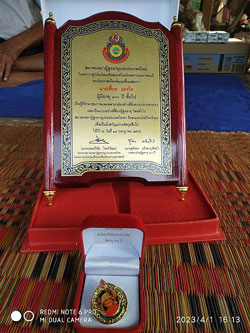
In translation, it reads approximately:
The Association Of Senior Citizens in Thailand
(under the patronage of the late king’s mother)
certifies that Mr Feuay Dtaeng-rid
who is over 100 years old,
has maintained good health,
has been a good role model for all,
and deserves recognition.
The Association therefore presents this plaque
to honor this man’s contribution to the Kingdom
Given on 18 July 2022.Dr Wichai Chokewiwat Mrs Supatra Geochansin
President of Association President of Those Over
of Senior Citizens 100 Years Old
in Thailand
Williams-Hunt Collection
The selection of aerial photos doesn’t extend nearly far enough beyond Kengtung to view the various road projects ordered by Phibun.
| First published on Internet | ||
Last Updated on 29 February 2024
- See BZ992 and EV940.[↩]
- Interview on Saturday, 01 April 2023 with
Feuay Dtang-rid
109 Moo 2
Dtambon Koong-dtapao
Amphoe Meung, Uttaradit
[เฟื้อย แตงริด
109 หม 2
ตำบลคุ้งตะเภา
อำเภอเมือง อุตรดิตถ์]Photo of Feuay by author: IMG_20230401_160901.jpg [\02370 Kengtung\Feuay.jpg].[↩]
- Location map from Wikipedia: Uttaradit.[↩]
- The following six bulleted paragraphs are a minimal summary of events relevant to Feuay. Reader should consult such Wikipedia articles as: Saharat Thai Doem, Phayap Army, Thai offensive into China, for more detail.[↩]
- Wikimedia: Saharat Thai Doem. [↩]
- Edward Young, Aerial Nationalism (Washington: Smithsonian, 1995), 182.[↩]
- Wikipedia: Saharat Thai Doem History.[↩]
- Young, ibid, 190.[↩]
- Stowe, Judith A, Siam becomes Thailand (Honolulu: Univ of HI Press, 1991), 240.[↩]
- ประวัติศาสตร์การสงครามของไทย
ในสงครามมหาเอเชียบูรพา
(กรมยุทธศึกษาทหาร กองบัญชาการทหารสูงสุด พ.ศ.๒๕๔๐)
[The History of Thailand’s Armed Forces During the Great East Asia War (Bangkok: Amarin Printing and Publishing, 1997), hereafter RTA History], 194.[↩] - Young, ibid, 197.[↩]
- Ibid.[↩]
- Unless otherwise noted, the source for the next eight paragraphs is Feuay.[↩]
- RTA History, 151: the replacement bridge in the area of Mong Lin on Road Project 1.[↩]
- RTA History, 195: an engineering unit working at Mong Hpayak, possibly on Road Project 1.[↩]
- Axis History Forum. Wisarut Bholsithi in “Thailand in WWII photos” on 21 Jun 2004.[↩]
- RTA History, pp 197-200.[↩]
- Wikimedia: Saharat Thai Doem.[↩]
- RTA History, 175, with markup (translations) inserted by author using Microsoft Publisher.
Map title:
Phayap Army Front 3rd Stage
Battle on the Burma-China
border 7-15 December 1943
[\02370 Kengtung\RTA
History\Maps\Tactical
map.jpg].[↩] - Google Maps of Saharat Thai Doem area, annotated by author using Microsoft Publisher
[\02370 Kengtung\RTA History\Maps\Composite map.jpg].[↩] - Tables based on RTA History text, 196. All distances in parentheses are from RTA History. All coordinates are for locations found on Google Earth, unless otherwise noted.[↩]
- Road Project 1 follows present day Burma Route 4 from Mai Sai, Thailand to Kengtung; the road north from there to Mongyang carries no Burma Route number.[↩]
- The road northeast to Mong Chiang-lau splits off the Kengtung-Mongyang Road at Ban Nong Kang which is defined as being 17 km north of Kengtung (it is not shown on any map).[↩]
- Mong Chiang-lau is presumably opposite Mongla across the Lum River in China.[↩]
- The description in RTA History plus that in The Motor Roads of Burma suggests this route goes through Loi Mwe. Doi in Thai and Loi in Burmese both mean mountain, and Mei may be the Thai rendering of the Burmese Mwe.[↩]
- Pang Mao not found, but assumed to be at intersection of unnamed road heading south from Loi Mwe and intersecting Burma Route 4 at coordinates shown.[↩]
- The road going north-easterly from Mong Hpayak follows Burma Route 49 as far as Mongyawng, where the route designation ends.[↩]
- This town was misspelled in the RTA listing as เนืองยู้; ie, with a น instead of a ม.[↩]
- An alternate spelling used on the tactical map is เชียงขาง; ie, with an า in place of an อ.[↩]
- Wan Ha is the only town in the immediate area and is almost exactly the specified 24 km from Mongyu.[↩]
- The descriptions of second priority roads do not include intermediate locations; thus, each listing is just origin-destination. The map symbols column shows the original order of the roads as listed in RTA History. They are here reordered in the cardinal directions from north clockwise.[↩]
- The description reads, in translation, “Extend old road in Mongyu, ยู้, to north border”. However, the “north border” isn’t readily accessible from Mongyu. More likely the intended starting point was the north end of Project Road 1; ie, Mongyang, ยาง, and that is what is tracked on the map.[↩]
- RTA History, 195.[↩]
- Extracts from
The Official Chronology of the US Army Airforce in World War II: 1944.[↩] - Following three items are extracts from:
The Official Chronology of the US Army Airforce in World War II: 1945.[↩] - The Motor Roads of Burma (Fourth Edition) (Rangoon: The Burmah Oil Co, (Burma Trading) Ltd, 1948).[↩]
- Ibid, 64. This describes part of Phibun’s Project Road 1. “Metalled” road here probably means “stone chips mixed with tar to form a road-surfacing material tarmac”. (Wikipedia: Road Surface, Gravel surface).[↩]
- Ibid, 65. This contrasts Phibun’s Project Road 4 with China’s connecting road at that time. While the border is actually at least another 37 miles (60 km) beyond Mongyaung, the descriptions of road quality are probably accurate.[↩]
- Ibid, 66.[↩]
- Photo of plaque by author: IMG_20230401_161345 [\02370 Kengtung\Feuay medal.jpg].[↩]


